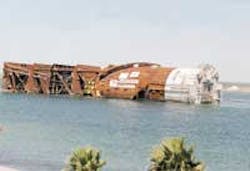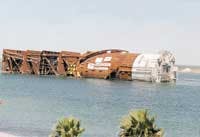Subsea/Surface Systems
William Furlow, Houston
First truss Spar installed
Kerr-McGee's Boomvang and Nansen projects in East Breaks Blocks 643 and 602 of the Gulf of Mexico have become the first applications of the truss Spar design. Dave Hager, Kerr-McGee Vice President, Gulf of Mexico and Worldwide Deepwater E&P, said the design was a natural outgrowth of the original Neptune Spar.
When Neptune was installed, Hager said, there were a number of sensors attached to it allowing the operator to study how the Spar performed in different sea states. Armed with this data, the company and the inventor, Ed Horton, set out to design a next generation hull that would improve on the Spar. The truss Spar looks like a traditional deep-draft caisson, but with one major difference: below the familiar cylindrical hard tank is a series of lattices connecting three large heave plates and a keel tank.
This addition to the hull increases the topsides capacity, while maintaining the same overall weight as a traditional Spar, Chuck Meloy, Kerr-McGee Vice President, Gulf of Mexico Deepwater, said. In addition to improved buoyancy, the open-truss design cuts down on the current load of the hull, and the flat plates dampen the hulls heave response. Meloy said the design uses the same amount of steel as a traditional Spar, but is easier to fabricate.
Meloy said the hulls of Neptune and Nansen both weighed about 12,000 tons, but while Neptune could carry topside loads of 6,500 tons, Nansen has a capacity of 8,700 tons. "For the same amount of steel, this design carries a greater operating load," he said. The Spars are being moored on three sets of three taut lines in about 3,600 ft water depth. Each of the nine moorings consists of a permanent anchor pile, anchor chain, jacketed steel spiral strand wire, platform chain, underwater fairlead, and a chain jack.
Nansen, the first to be installed, will produce nine wells at the Spar, using dry trees, as well as three subsea wells that will be tied back from a site a little over two miles away, Hager said. The Nansen Spar production capacity is 40,000 b/d and 200 MMcf/d. Kerr-McGee holds 50% interest and operates Nansen with partner Ocean Energy, which holds the other 50%.
While the design of the truss Spar is different, the installation procedure is very similar. The Spar is floated out on its side, and then up-ended on site. The mooring lines are connected, and it is winched into place. The key difference here, Meloy said, is how the Spar is up-ended. On Neptune, the lower portion of the hard tank was partially flooded tipping the Spar vertical in one dramatic motion. For the truss Spar, the process is much more gradual. "This is more of a controlled flooding," Meloy said.
The keel tank is flooded first, rotating the Spar 19 degrees. At this point, a chamber in the lower portion of the main hull, or hard tank, is flooded gradually rotating the Spar so that it sits upright. The entire process takes around 12 hours, as opposed to the 90 seconds it took the Neptune Spar to travel the last 72 degrees. While such a gradual process is less stressful for the team installing the hull, Meloy said it also exerts less stress on the hull itself.
Less than a month after Nansen was installed, Boomvang was making its way to the East Breaks. Boomvang has the same production capacity as the Nansen facility. The initial development will include five dry tree wells and thee subsea wells connected to the spar. Kerr-McGee is the operator on Boomvang with 30% interest; Ocean Energy holds 20%; Enterprise Oil has the remaining 50% interest. Meloy said there were some minor adjustments made in the installation procedure, but basically the process was identical for both structures.
While Kerr-McGee learned lessons from operating the Neptune Spar, it also took advantage of this platform to train the crews for the two new Spars. Hager said the crews on both Boomvang and Nansen worked on Neptune, so they could receive their training in a Spar environment.
Looking ahead, Hager said Kerr-McGee will install another truss Spar on the Gunnison prospect in Garden Banks Blocks 667-669. Partners on this project are Kerr-McGee, operator, 50%, Nexen Inc., 30%, and Cal Dive International, Inc., 20%. This field, located in 3,100 ft water depth, is expecting production in early 2004.
Talisman trees FMC
FMC Energy Systems has been awarded a frame contract with Talisman Energy to provide subsea trees, wellheads, and associated equipment in the North Sea. The company also signed a similar agreement with Soekor E&P to provide subsea equipment and technology solutions for the Sable Development project offshore South Africa.
The Talisman frame agreement is for a period of seven years, with an option to extend for an additional three years, and will potentially cover the supply of more than 40 subsea wellhead and tree systems. Initial deliveries under the agreement are scheduled to commence in 2002.
Soekor's Sable Development is located 93 miles southwest of Mossel Bay in the Western Cape of South Africa in 328 ft water depth. The subsea completion solution will be managed and manufactured by FMC's Dunfermline, Scotland facility. The Sable solution will consist of six subsea trees, comprising four producers, a gas injector, and a water injector. The agreement includes an option for two additional production trees. Equipment deliveries have begun and will culminate in the first quarter of this year.


